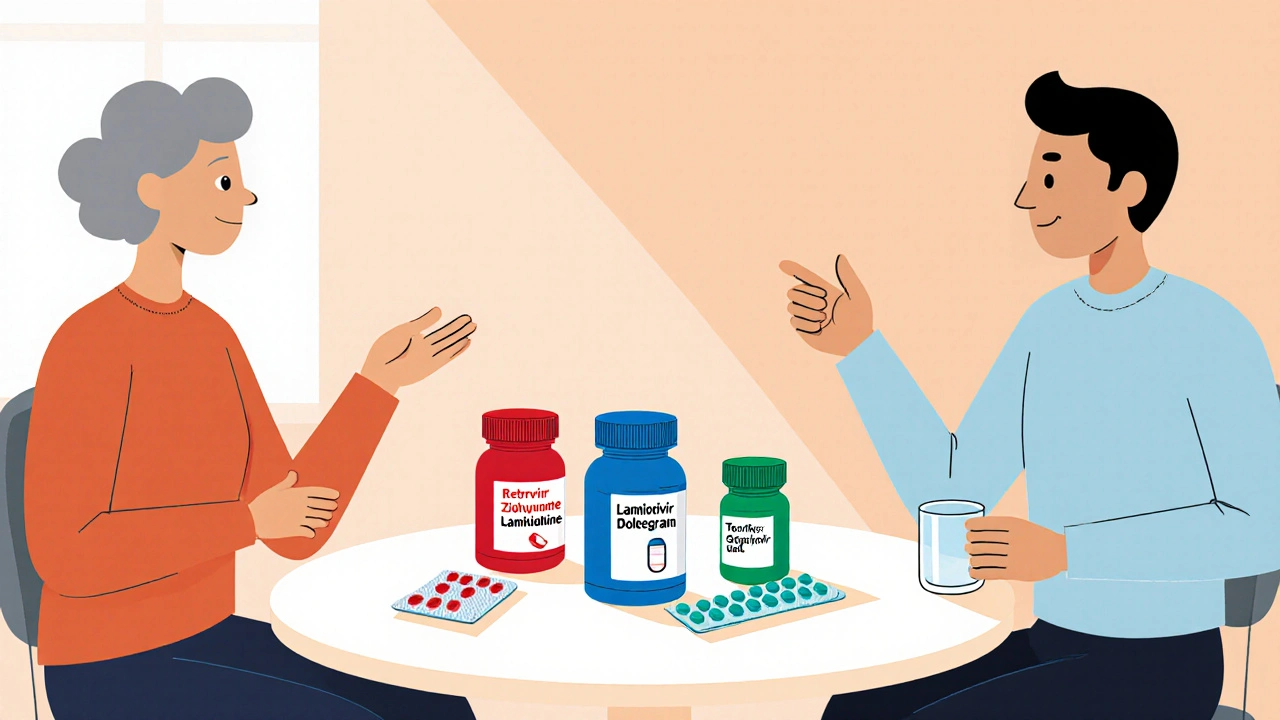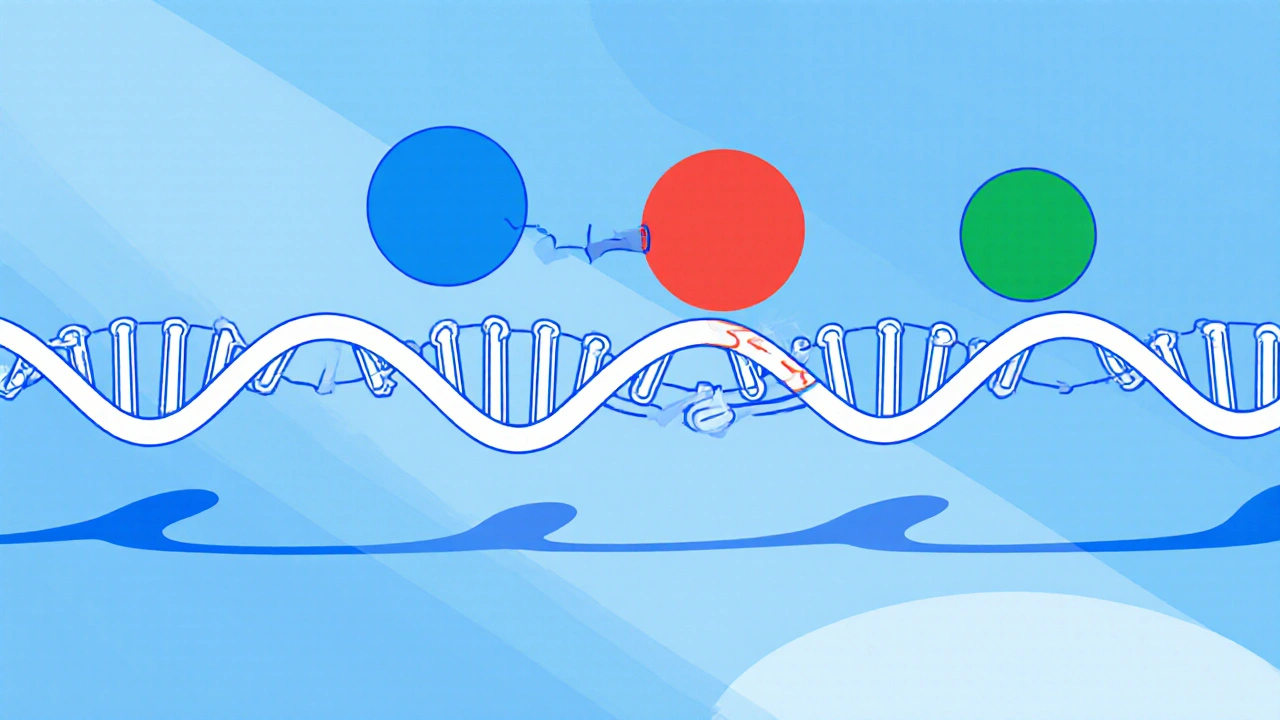
Key Takeaways
- Retrovir (Zidovudine) is effective but has a lower resistance barrier than newer NRTIs.
- Lamivudine and Emtricitabine offer once‑daily dosing with better tolerability.
- Tenofovir (TDF/TAF) provides strong viral suppression and a high genetic barrier.
- Switching to newer agents can reduce anemia and mitochondrial toxicity.
- Cost, pregnancy safety, and drug‑drug interactions remain critical when choosing an alternative.
When you or a patient need to decide whether to stay on Retrovir or move to a newer regimen, the choice hinges on efficacy, side‑effects, resistance patterns, and real‑world practicality. This guide walks through the science, the numbers, and the everyday considerations that matter most.
What Is Retrovir (Zidovudine)?
Retrovir (Zidovudine) is a nucleoside reverse transcriptase inhibitor (NRTI) approved in 1987 as the first approved drug for HIV‑1 infection. It mimics the natural nucleoside thymidine, gets incorporated into viral DNA, and stops the reverse‑transcriptase enzyme in its tracks. The drug is also known by its chemical name Zidovudine and the brand name Retrovir.
How Retrovir Works
Zidovudine’s active form, zidovudine‑triphosphate, competes with the natural substrate deoxy‑thymidine‑triphosphate. When reverse transcriptase adds zidovudine‑triphosphate to the growing viral DNA strand, it lacks the 3’‑OH group needed for the next nucleotide to bind, leading to chain termination. This mechanism makes it a cornerstone of early combination therapy, but it also means the virus can quickly develop resistance through mutations in the reverse‑transcriptase gene.
Clinical Efficacy and Safety Profile
Large trials from the 1990s showed that zidovudine reduces plasma HIV‑RNA by about 1.5-2.0 log copies/mL after 12 weeks when used in combination with other antiretrovirals. Modern meta‑analyses, however, reveal that newer NRTIs achieve similar or greater reductions with fewer adverse events. The most common side effects of Retrovir are:
- Anemia (up to 20% of patients)
- Neutropenia
- Myopathy and mitochondrial toxicity (long‑term use)
- Nausea and headache
Because of these issues, clinicians often reserve zidovudine for specific scenarios - such as when resistance to other NRTIs limits options, or when cost constraints dominate the decision.

Criteria for Comparing Antiretrovirals
When you line up Retrovir against alternatives, keep these five dimensions in mind:
- Efficacy: Ability to drop viral load below detection and sustain it.
- Resistance Barrier: How many mutations the virus needs to escape the drug.
- Safety & Tolerability: Frequency of anemia, renal toxicity, mitochondrial effects, etc.
- Dosing Convenience: Once‑daily vs multiple doses, food requirements.
- Cost & Accessibility: Generic availability, insurance coverage, global health program support.
Alternatives to Retrovir
The antiretroviral landscape has broadened dramatically. Below is a quick snapshot of the most common alternatives, each introduced with concise microdata.
Lamivudine (brand name Epivir) is a cytidine analogue NRTI that offers once‑daily dosing and a high safety profile.
Abacavir (brand name Ziagen) is a guanosine analogue NRTI prized for its low renal toxicity but requires HLA‑B*57:01 screening to avoid hypersensitivity.
Tenofovir disoproxil fumarate (TDF) and its newer pro‑drug Tenofovir alafenamide (TAF) are phosphonate NRTIs with strong viral suppression and a high resistance barrier.
Emtricitabine (FTC, brand name Emtriva) pairs well with tenofovir, sharing a similar safety profile but with a longer intracellular half‑life allowing once‑daily dosing.
Dolutegravir (DTG, brand name Tivicay) is an integrase strand transfer inhibitor (INSTI) that delivers rapid viral load decline and a high genetic barrier. While not an NRTI, it is commonly used in regimens that replace zidovudine.
Head‑to‑Head Comparison Table
| Drug | Class | Typical Dose | Viral Load Reduction | Resistance Barrier | Key Side Effects | Pregnancy Safety | Cost (USD/month) |
|---|---|---|---|---|---|---|---|
| Retrovir (Zidovudine) | NRTI | 300 mg twice daily | ~1.5-2 log drop | Low (M184V, K70R) | Anemia, neutropenia, myopathy | Category C (use if benefits > risks) | ~$10 (generic) |
| Lamivudine | NRTI | 150 mg daily | ~1.5 log drop | High (M184V gives high barrier when combined) | Generally well‑tolerated | Category C (well studied) | ~$12 |
| Abacavir | NRTI | 600 mg daily | ~1.5-2 log drop | Medium (K65R) | Hypersensitivity (HLA‑B*57:01), myocardial infarction risk | Category B | ~$20 |
| Tenofovir DF (TDF) | NRTI | 300 mg daily | ~2 log drop | High (K65R, multiple mutations needed) | Renal toxicity, bone loss | Category B | ~$15 |
| Tenofovir AF (TAF) | NRTI | 25 mg daily | ~2 log drop | High | Less renal/bone impact than TDF | Category B | ~$30 |
| Emtricitabine | NRTI | 200 mg daily | ~1.8 log drop | High (M184V often co‑selected) | Generally well‑tolerated | Category C | ~$12 |
| Dolutegravir | INSTI | 50 mg daily | ~2.5 log drop (fast) | Very high (few integrase mutations) | Weight gain, insomnia | Category C (data supporting safety) | ~$25 |
When to Stay on Retrovir
If a patient is already virologically suppressed, has no anemia, and the regimen is affordable, staying on zidovudine can be a pragmatic choice. Some national programs still list Retrovir as a first‑line option because of its low price and long‑standing supply chain reliability.
When to Switch to a Newer Agent
Consider swapping if any of these apply:
- Developing anemia or neutropenia despite supplementation.
- Evidence of M184V or K70R mutations reducing zidovudine potency.
- Desire for once‑daily dosing to improve adherence.
- Pregnant patients where data favor lamivudine or tenofovir.
- Availability of fixed‑dose combos (e.g., TDF/FTC) that reduce pill burden.
Practical Tips for Switching Regimens
- Baseline labs: CBC, renal function, and hepatitis B status.
- Resistance testing: Genotype to confirm absence of key NRTI mutations.
- Gradual transition: If moving to tenofovir‑based combo, start the new drug on day 1 and stop zidovudine after 7 days, monitoring for viral rebound.
- Adherence counseling: Emphasize once‑daily schedule benefits.
- Follow‑up: Re‑check viral load at 4 and 12 weeks post‑switch.
Bottom Line
Retrovir was a breakthrough in the 1980s, but today clinicians have a richer toolbox. Newer NRTIs and INSTIs deliver stronger viral suppression, fewer blood‑related side effects, and simpler dosing. Yet, the low cost and wide availability of zidovudine keep it relevant for resource‑limited settings. The right choice boils down to patient‑specific factors: lab values, resistance profile, pregnancy plans, and insurance coverage.
Is Retrovir still recommended as first‑line therapy?
In most high‑income countries, guidelines now favor tenofovir‑based regimens or integrase‑inhibitor combos over zidovudine. However, in low‑resource settings where cost is paramount, Retrovir remains an acceptable option if patients are monitored for anemia.
Can I switch from Retrovir to tenofovir without a treatment gap?
Yes. Most clinicians overlap the new tenofovir‑based pill for one week while continuing zidovudine, then discontinue Retrovir after confirming no adverse reactions. Close viral load monitoring is essential.
What are the major side effects that differentiate Zidovudine from Lamivudine?
Zidovudine commonly causes macrocytic anemia and neutropenia, while lamivudine’s safety profile is mild, with occasional gastrointestinal upset. This makes lamivudine preferable for patients with baseline low hemoglobin.
Is there any advantage of Abacavir over Zidovudine for pregnant women?
Abacavir is classified as Category B for pregnancy, indicating animal studies have not shown risk, whereas Zidovudine is Category C. Nonetheless, many guidelines still recommend zidovudine for prevention of mother‑to‑child transmission because of robust data supporting efficacy.
How does the cost of Tenofovir alafenamide compare to Retrovir?
TAF is roughly three times more expensive than generic Zidovudine in the United States. In low‑income countries, donor programs may subsidize TAF, but otherwise Retrovir remains the cheaper option.




9 Comments
Retrovir still works if you’re watching the wallet and the viral load’s under control.
Just keep an eye on hemoglobin levels.
One must acknowledge the epistemic superiority of tenofovir‑based regimens; zidovudine’s pharmacodynamic profile is antiquated and imposes a suboptimal therapeutic index. The clinical inertia perpetuated by cost‑driven algorithms fails to appreciate the mechanistic robustness of high‑barrier agents.
Honestly, clinging to Retrovir is a relic of low‑resource practice; modern clinicians should have already transitioned to agents with better tolerability and resistance profiles.
Sticking with zidovudine only makes sense in a pinch-otherwise you’re just gambling with anemia.
Hey there 😊 if you’re worried about the side effects, remember that regular CBC checks can catch anemia early and you can always discuss a switch with your doc. You’re not alone in navigating these meds!
The decision to persist with Retrovir versus adopting a newer nucleotide analogue should be anchored in a comprehensive assessment of virologic efficacy, safety, and patient‑centred considerations.
First, the magnitude of viral load reduction afforded by zidovudine, although historically pivotal, is modest when juxtaposed with the robust suppression achieved by tenofovir alafenamide or dolutegravir.
Second, the hematologic toxicity profile, particularly macrocytic anemia and neutropenia, imposes a tangible burden on patients with pre‑existing marrow compromise.
Third, resistance barrier analysis reveals that zidovude’s low genetic threshold facilitates rapid emergence of M184V and K70R mutations, whereas agents such as TAF demand multiple concurrent alterations for virologic escape.
Fourth, adherence is markedly enhanced by once‑daily dosing regimens; twice‑daily Retrovir may precipitate missed doses in individuals with complex schedules.
Fifth, the pharmacoeconomic landscape cannot be ignored; while generic zidovudine remains inexpensive, the long‑term costs associated with managing anemia and monitoring may offset initial savings.
Moreover, pregnancy considerations underscore that lamivudine and tenofovir possess more favorable safety categorizations and extensive obstetric data.
In clinical practice, baseline laboratory evaluation-including CBC, renal function, and hepatitis B status-should precede any regimen modification.
Genotypic resistance testing is indispensable to ascertain the presence of NRTI‑associated mutations that would diminish zidovudine’s potency.
When transitioning to a tenofovir‑based combination, a prudent overlap of one week mitigates the risk of viral rebound.
Patients should be counseled on the anticipated improvement in hemoglobin levels and the reduction in pill burden.
Follow‑up viral load measurements at weeks four and twelve provide objective confirmation of sustained suppression.
Should adverse events arise with the new agents, clinicians must be prepared to adjust dosing or consider alternative backbones.
Ultimately, the therapeutic algorithm must be individualized, weighing the objective data against the subjective preferences and socioeconomic context of each patient.
By integrating evidence‑based guidelines with diligent monitoring, providers can optimize outcomes while minimizing toxicity.
Therefore, while Retrovir retains a niche role in resource‑limited settings, the preponderance of data advocates for migration to higher‑barrier, better‑tolerated antiretrovirals whenever feasible.
So, the PK/PD of zidovudine kinda lags behind TDF/TAF – the half‑life is shorter and you need that BID schedule, which isn’t ideal for real‑world adherence.
I get why some patients stick with Retrovir; the cost factor is real and if you’re already suppressed it can feel safe. However, think about the long‑term iron‑deficiency risk and how a once‑daily pill could simplify life. Talk to your provider about a gradual switch and keep those labs tight. You’ve got options, and the right one depends on your whole health picture.
Switch to TAF already!! 💥💊